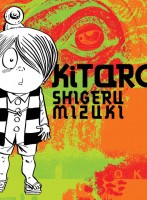 Creator: Shigeru Mizuki
Creator: Shigeru Mizuki
U.S. publisher: Drawn & Quarterly
ISBN: 9781770461109
Released: August 2013
Original release: 1967-1969
Over the last few years I have become increasingly interested in yokai—Japan’s supernatural beings and monsters of myth and legend. When it comes to yokai manga the most influential creator in Japan is Shigeru Mizuki. His most famous series GeGeGe no Kitaro is considered a classic and continues to inspire others. I was absolutely thrilled when Drawn & Quarterly announced that GeGeGe no Kitaro had been licensed in English. Kitaro, released in 2013, collects stories from the first few volumes of Mizuki’s GeGeGe no Kitaro published in Japan between 1967 and 1969. Also included in Drawn & Quarterly’s Kitaro is an excellent introduction by Matt Alt (one of the co-authors of Yokai Attack!) and a yokai glossary by Zach Davisson, both of which are particularly useful for readers who aren’t familiar with Kitaro or yokai, but which should also be interesting for those who are more knowledgeable.
“It is said that when the crow caws thrice, and the frog responds twice, the appearance of Kitaro is imminent.” Kitaro of the Graveyard, a one-eyed yokai in the form of a young boy whose ways are mysterious and who wields great spirit powers. Generally a friendly sort of fellow, Kitaro helps protect people from more malicious yokai although unscrupulous humans might find themselves on the losing end of an encounter with him as well. Sometimes working alone and sometimes enlisting the help of other yokai, Kitaro’s adventures take him all over Japan, everywhere from its most densely populated cities to its most remote islands and beyond. It is part of Kitaro’s mission to defeat evil yokai. The spirits and monsters that he faces will take all of the esoteric knowledge and supernatural skills he has to vanquish them, not to mention a little luck.
The stories in Kitaro tend to be episodic and vary in length—most are around fifteen pages while the longest could easily be collected as their own graphic novels. Although the stories aren’t directly related, many share recurring characters. The most notable are Kitaro himself, his father Medama Oyaji—an eyeball with a body who resides in Kitaro’s empty eye socket and enjoys a good teacup bath—and Nezumi Otoko—a half-human, half-yokai troublemaker and sometimes friend. Mizuki was inspired by more than just Japanese folklore when creating Kitaro. In addition to traditional yokai and his own imagination, popular culture and more modern kaiju were also important influences. Even monsters from Western literature, film, and mythology make an appearance. As a result, Kitaro is a lively amalgamation of sources.
I found Kitaro to be utterly delightful. Although it is a horror manga dealing with powerful supernatural creatures and featuring some legitimately creepy scenarios, Kitaro is also very funny and even cheerful in tone. Kitaro does seem to gain abilities as is convenient to the story, but it is still amusing to see how he manages to get out of precarious situations. It can be a bit silly at times, and on occasion deceptively simple and straightforward, but Kitaro is also a great deal of fun. Because of its episodic nature there isn’t much plot or character development, but Mizuki’s creations are still memorable. I particularly appreciate all of the different traditions he draws from to create a tale that is distinctly his own. I loved Kitaro and enjoyed the volume immensely. I sincerely hope that Drawn & Quarterly will be able to release more of the series.

[…] 2013, comics publisher Drawn & Quarterly released Kitaro a volume collecting stories from Shigeru Mizuki’s most well-known and beloved manga series […]